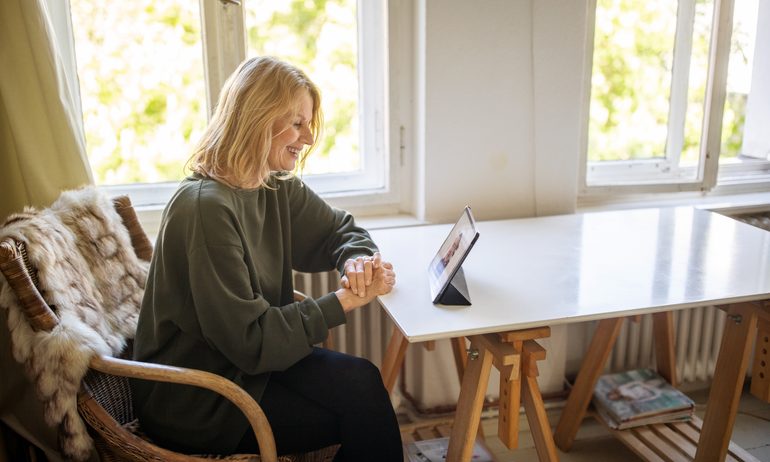How to Be a Better Long-Distance Caregiver
Get the most out of technology, local helpers and available benefits when caring for a loved one from afar.

Many, or all, of the products featured on this page are from our advertising partners who compensate us when you take certain actions on our website or click to take an action on their website. However, this does not influence our evaluations. Our opinions are our own. Here is a list of our partners and here's how we make money.
Long pandemic lockdowns forced many older adults to become comfortable with video calls to stay connected with family. That in turn means that long-distance caregivers have a better way to see how their loved ones are faring.
“You can't tell on the phone that they're wearing the same clothes every day, or they’re not bathing because they’re afraid they’ll fall in the shower,” says Amy Goyer, AARP's national family and caregiving expert and the author of “Juggling Life, Work, and Caregiving.”
More than 1 in 10 caregivers look after family or friends from a distance, which can make the task much more difficult and expensive. A 2016 AARP survey found that caregivers in general incur an average of about $7,000 a year in out-of-pocket expenses. Long-distance caregivers — those who live at least an hour away from the care recipient — incur about $12,000 on average, according to the survey. Long-distance caregivers are more likely than local caregivers to hire help, take unpaid time off work and pay for travel, Goyer says.
Yet many distant caregivers worry they’re not doing enough and that a preventable crisis will develop because they weren’t on hand to spot the red flags.
“As caregivers, guilt is our constant companion,” Goyer says. “When you're a long-distance caregiver, it's even more so.”
AARP has numerous resources for caregivers, including a “Prepare to Care” planning guide and a financial workbook for estimating and tracking costs. Goyer, who cared for her grandparents, parents and a sister from afar, suggests the following ideas to make long-distance caregiving more effective and manageable.
Assemble a team
If you can’t physically check in on your loved one regularly, enlist others who can, Goyer says. Those could include family members or friends who live closer, or even a friendly neighbor to whom you can give your contact information.
“You may say, ‘Hey, if you notice grass isn’t getting mowed, things around the house look like they're not being kept up, will you let me know?’” Goyer suggests.
If you have siblings, they can pitch in even if they’re long-distance too, Goyer says. They can make daily check-in calls or handle tasks such as paying bills, making medical appointments and dealing with insurance companies.
If you have the means, consider hiring a geriatric care manager, also known as an aging life care professional, to help you evaluate your loved one’s caregiving needs, hire home health aides if necessary and step in if there’s a crisis. These professionals, who are often nurses or social workers, typically charge $75 to $200 an hour. An initial assessment may cost a few hundred dollars, but then the manager can be tapped as needed.
“If my parents had to go to the hospital or some emergency happened, there had to be somebody right away who could deal with it,” Goyer says.
Embrace technology
Video calling isn’t the only technology that can make life easier for long-distance caregivers. Medical alert systems can allow a loved one to summon aid, and some have fall detection technology that works even if the person isn’t wearing a special device. Smart pill dispensers manage medications, and some can let caregivers know if doses aren’t taken.
Smart home systems can also help. A smart door lock, for example, can allow you to grant access to someone such as a friend, a health aide or a paramedic from afar. A smart thermostat can help you ensure a comfortable temperature, while a smart home security system can let you know if your loved one has left the house. Goyer used security cameras to keep an eye on her dad “whether I was going outside to take out the trash or 2,000 miles away.”
Maximize available resources
Your loved one may be eligible for public benefits that could help with caregiving tasks or costs. Start your search at Benefits.gov. Resources for older Americans can also be found through the U.S. Administration on Aging's Eldercare Locator.
Goyer’s father suffered from dementia for many years, but only during the last year of his life did she learn that he qualified for health care benefits from the Department of Veterans Affairs.
“I wish I'd gotten him into VA health care earlier, because they ended up covering incontinence supplies and medications and a lot of things that I had been paying for,” Goyer says.
The person you’re caring for may have other resources that can be tapped, such as long-term care insurance, savings or home equity. Talking about money can be difficult, but not doing so can be disastrous, Goyer says. She eventually filed for bankruptcy protection because of the credit card debt she incurred while caregiving.
If she had it to do again, Goyer says she would consult with a financial advisor to better plan for the costs ahead.
“My biggest advice is to realize that this could go on a long time and can have an impact on your own personal finances,” she says.
This article was written by NerdWallet and was originally published by the Associated Press.





